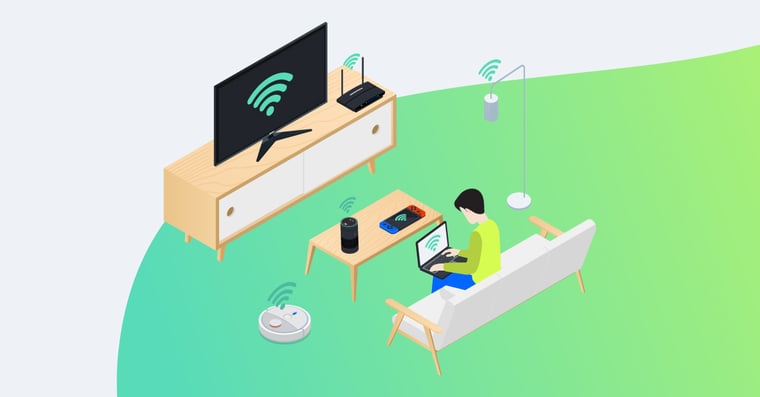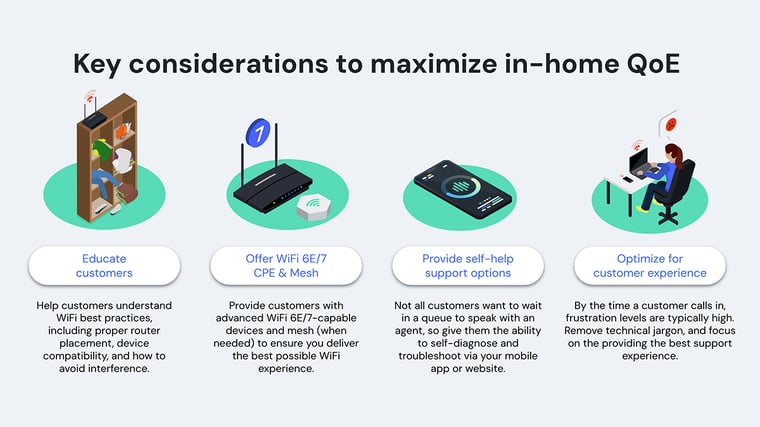Residential WiFi QoE in the age of Wi-Fi 6E/7

Wi-Fi 6E residential gateways, routers, and access points have been available since 2021, and the Wi-Fi 7 standard is expected to be ratified near the end of 2024. Pre-standard Wi-Fi 7 routers are already commercially available. While the latest developments in WiFi are technically impressive, will they meet the needs and expectations of your residential subscribers?
In this blog and our recent webinar, we examine the impact of Wi-Fi 6E/7 on the Quality of Experience (QoE), a subscriber-centric metric that measures closer to customer satisfaction than the traditional Quality of Service (QoS).
What’s new in Wi-Fi 6E/7?
First, let’s have a look at some of the new capabilities and features in Wi-Fi 6E/7:
|
Wi-Fi 5
|
Wi-Fi 6
|
Wi-Fi 6E
|
Wi-Fi 7
|
|
|
Frequency Bands
|
Dual-band: 2.4 / 5 GHz
|
Tri-band: 2.4 / 5 / 6 GHz
|
||
|
Max Speed
|
3.5 Gbps
|
9.6 Gbps
|
46 Gbps
|
|
|
Max Channel Size
|
160 MHz
|
320 MHz
|
||
|
Security
|
WPA2
|
WPA3
|
WPA3/4
|
|
|
IEEE Standard
|
802.11ac
(2013)
|
802.11ax
(2019)
|
802.11ax
(2021)
|
802.11be
(2024)
|
Speed
One of the key improvements of Wi-Fi 7 is that it can be over 4X faster than Wi-Fi 6 (thanks to a doubling of the channel size and a higher order QAM modulation). While no single device in the home can (currently) consume 46 Gbps, the bandwidth needs of a large, tech-savvy household during peak hours can be significant and will continue to grow.
However, the limiting factor is not in the home, but in the last mile. Most FTTH and HFC access networks max out at 10 Gbps per subscriber, so Wi-Fi 7’s impressive bandwidth cannot be fully utilized for internet access. Once 50G-PON is rolled out in the service provider’s access network, Wi-Fi 7 speed becomes attainable.
Range
The biggest headline for Wi-Fi 6E/7 is the release of the 6 GHz band. It’s new, unused, and free from interference – similar to the 5 GHz band when it launched. This is a clear win for QoE, but its impact is tempered by the short range of 6 GHz. The higher the frequency band, the shorter the range and the smaller the coverage, so the benefits of 6 GHz are largely limited to same/next-room devices. This caveat doesn’t always make it into the hype around 6 GHz, so subscriber expectations will likely far exceed reality.
To fully experience 6 GHz throughout most homes, a mesh WiFi system will be required.
Latency
Much of the latency in WiFi arises from contention, when two or more devices try to transmit data at the same time. When this happens, both devices have to back off and retransmit later. Wi-Fi 6 introduced OFDMA (orthogonal frequency division multiple access, also used in 5G), which allowed multiple devices to send/receive data simultaneously. Wi-Fi 7 adds MLO (multi-link operation), which allows devices to use two frequency bands concurrently to further improve reliability and latency.
Gamers and AR/VR enthusiasts will clearly enjoy an improved QoE when they upgrade to Wi-Fi 6. Besides improving latency, OFDMA significantly improves WiFi performance when a large number of devices are active.
Devices
The average U.S. home has 22 smart devices, a number that continues to increase every year. And therein lies the challenge of lagging device support. Mobile phones have quick refresh cycles, smart TVs take longer to get replaced, and smart light bulbs can last up to 25,000 hours. High-end products often sport the latest tech, while many mass-market products will remain 2.4GHz-only.
Wi-Fi 7 adoption in the home will depend on the refresh cycles of the different device types. However, it will likely take several years for the subscriber QoE to reach a tipping point where the benefits are broadly experienced across multiple devices and applications.
Interoperability
In 2023, some 3.8 billion WiFi devices will be shipped. There are close to 40 WiFi chipset vendors producing chips with varying capabilities and price points, so interoperability issues are to be expected. For example, the security protocol was upgraded to WPA3 in Wi-Fi 6 from WPA2 in Wi-Fi 5. Many smart home devices today continue to have challenges getting or staying connected to a Wi-Fi 6 router.
It would be prudent to expect that as in previous upgrade cycles, interoperability issues will arise and most will be resolved over time. In the early stages of adoption, an increase in tech support call volume is inevitable.

Our experience in the ongoing transition to Wi-Fi 6 has taught us that while new technology will solve some problems, it can create others, and that the same WiFi performance can result in different subscriber experiences.
Technology is just one part of the equation; subscriber behavior and expectations are the other. A balanced focus on all will be needed to maximize QoE and ultimately customer satisfaction.
To learn more, watch our webinar recording: Residential WiFi QoE in the Age of WiFi 6E/7, or book a demo and we can show you how you can transform the quality of experience for your subscribers.

